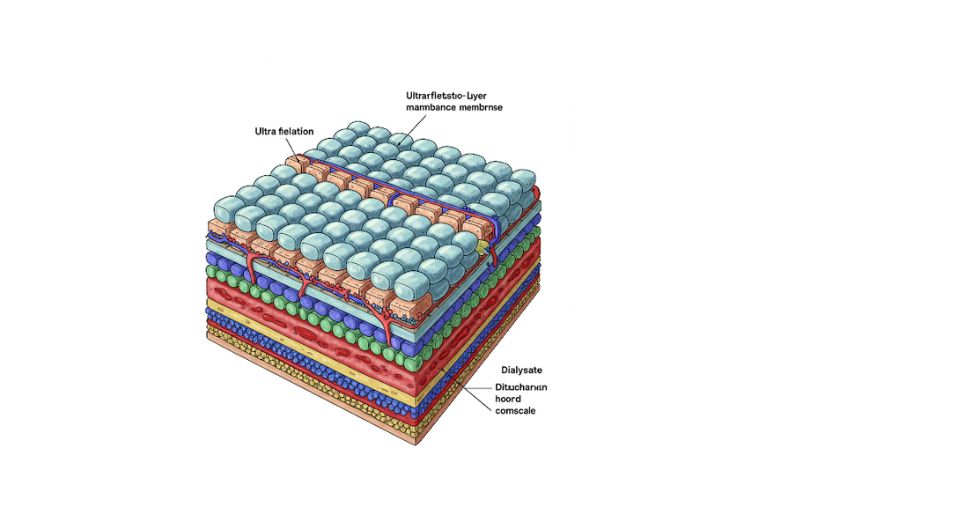
Mar 19, 2025

As per an analysis conducted by Metastat Insight, the Global Hemodialysis Membrane market is one that covers a significant area toward management and treatment of renal failure by advanced filtration technologies. Hemodialysis is where the membrane is placed in the pathway for cleaning blood by removal of waste, excess fluids, and toxins during dialysis treatments so that the embarrassed kidney function could assist patients.
Increasing cases of chronic kidney diseases have increased the demand for hemodialysis, and such continuous transformations in the hemodialysis membranes market-create new waves in material science and filtration efficiencies. The manufacturers and healthcare providers are now more into optimizing membrane performance-geared to enhance biocompatibility and mitigate complications related to treatment. Further developments in synthetic polymer membranes and high flux technology result in enhancing toxin clearance, improving patient outcomes, and minimizing their kidney treatment time, thus creating a win-win situation for medical professionals and patients alike.
Global Hemodialysis Membrane market is estimated to reach $667.6 million in 2025 with a CAGR of 8.3% from 2025 to 2032.
The assembly of dialysis membranes does change depending on what they are made of and what kind of permeability they possess, allowing effective simulation of solute removal from the bloodstream. In recent times, the trend has been changing towards membranes with higher permeability that are more effective in removing middle and large weight toxins. Minimum blood-membrane interaction leading to inflammatory responses has been their mantra for fast track clinical evaluation for the last imperfect design.
The dialectic deliberation between permeability and selectivity still holds a pivotal position to membranes design, for any compromise will affect dialysis efficacy adversely. The category of the high-flux membranes with high clearance capacity is being further developed for patients probably undergoing intensified dialysis treatment. Conventional cellulose-based membranes had their days serving the industry for a good 30 years, whereas polysulfone and polyethersulfone are now gaining preference over cellulose due to their enhanced performance, durability, and decreased chances of adverse immune reactions.
Regulatory authorities will always impose strict standards to ensure that hemodialysis membranes meet safety and efficacy benchmarks. These set rules and regulations ensure that membranes not only fulfill the purpose they are supposed to serve but also comply with other essential conditions of sterility and biocompatibility. Continuous examination of the interaction of the materials with blood components remains a pivotal area of concern among the manufacturers and researchers. Innovations in membrane coatings heighten patient safety by reducing issues related to clotting and biofilm formation.
Developing aspect is the change to home-based dialysis services that allow patients to receive treatment without frequent hospital visits. Portable and user-friendly dialysis machines include advanced membranes as they grow more technically capable of efficiently removing toxins in homes. Patients benefit by having added convenience, lower costs, and greater adherence to treatment schedules, while healthcare systems worldwide work toward addressing disparities in dialysis accessibility so that advanced membrane technology would benefit more people. The affordability of such a crucial topic is still best in underdeveloped countries because they can barely afford the health infrastructure to keep discussing how to produce these membranes at low cost without compromising quality.
Environmental considerations are equally emerging in membrane production and disposal. The high volume of waste produced due to the use of single-use dialysis components has prompted researchers to look for biodegradable and recyclable alternatives. Sustainability initiatives of the industry relate to minimizing the ecological footprint of dialysis treatments, a problem that requires the collaboration of manufacturers, health institutions, and policymakers. Using green materials in the membrane manufacturing process is likely going to drive future developments and steps in that direction vis-a-vis greater sustainability in medical technology.
Strategic partnerships and acquisitions have been decisive in transforming the competitive environment as companies seek to consolidate their positions in the market. The presence of top healthcare technology companies, coupled with small emerging pioneers specializing in membrane innovations, creates a dynamic environment where continuous research and product development are top priorities. Collaborations between biotechnology companies and manufacturers of medical devices will allow the introduction of membranes with improved features and will set new standards for efficiency in dialysis. Moreover, investments in digital integration, such as sensor-enabled dialysis systems, further enhance progress by enabling real-time monitoring of filtration performance and patient reaction.
As the need for effective dialysis treatment grows, this sector continues adapting technologies through medical breakthroughs and improvements in hemodialysis membrane technology. The Global Hemodialysis Membrane market, as it is discussed in the latest estimation of Metastat Insight, remains a very strategic segment in the mainstream of modern healthcare development; it is today the tissue that connects innovations with patients. With advances in material engineering, regulatory oversight, and sustainability efforts, the sector is bound to see further developments to ensure that dialysis treatments evolve with the increasing demand of an expanding patient population.
Drop us an email at:
Call us on:
+1 214 613 5758
+91 73850 57479